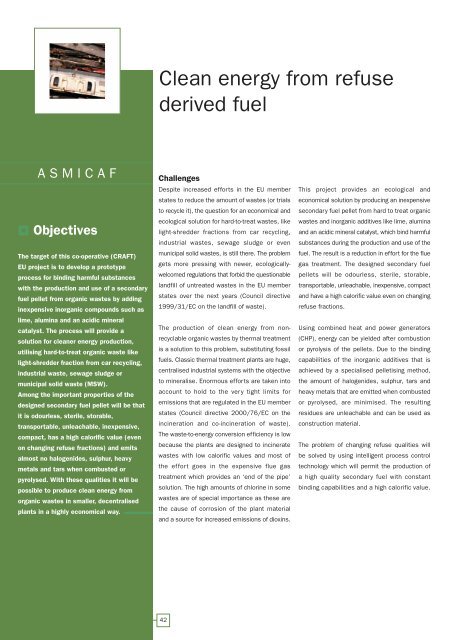European Bio-Energy Projects
European Bio-Energy Projects
European Bio-Energy Projects
You also want an ePaper? Increase the reach of your titles
YUMPU automatically turns print PDFs into web optimized ePapers that Google loves.
ASMICAF<br />
Objectives<br />
The target of this co-operative (CRAFT)<br />
EU project is to develop a prototype<br />
process for binding harmful substances<br />
with the production and use of a secondary<br />
fuel pellet from organic wastes by adding<br />
inexpensive inorganic compounds such as<br />
lime, alumina and an acidic mineral<br />
catalyst. The process will provide a<br />
solution for cleaner energy production,<br />
utilising hard-to-treat organic waste like<br />
light-shredder fraction from car recycling,<br />
industrial waste, sewage sludge or<br />
municipal solid waste (MSW).<br />
Among the important properties of the<br />
designed secondary fuel pellet will be that<br />
it is odourless, sterile, storable,<br />
transportable, unleachable, inexpensive,<br />
compact, has a high calorific value (even<br />
on changing refuse fractions) and emits<br />
almost no halogenides, sulphur, heavy<br />
metals and tars when combusted or<br />
pyrolysed. With these qualities it will be<br />
possible to produce clean energy from<br />
organic wastes in smaller, decentralised<br />
plants in a highly economical way.<br />
Clean energy from refuse<br />
derived fuel<br />
Challenges<br />
Despite increased efforts in the EU member<br />
states to reduce the amount of wastes (or trials<br />
to recycle it), the question for an economical and<br />
ecological solution for hard-to-treat wastes, like<br />
light-shredder fractions from car recycling,<br />
industrial wastes, sewage sludge or even<br />
municipal solid wastes, is still there. The problem<br />
gets more pressing with newer, ecologicallywelcomed<br />
regulations that forbid the questionable<br />
landfill of untreated wastes in the EU member<br />
states over the next years (Council directive<br />
1999/31/EC on the landfill of waste).<br />
The production of clean energy from nonrecyclable<br />
organic wastes by thermal treatment<br />
is a solution to this problem, substituting fossil<br />
fuels. Classic thermal treatment plants are huge,<br />
centralised industrial systems with the objective<br />
to mineralise. Enormous efforts are taken into<br />
account to hold to the very tight limits for<br />
emissions that are regulated in the EU member<br />
states (Council directive 2000/76/EC on the<br />
incineration and co-incineration of waste).<br />
The waste-to-energy conversion efficiency is low<br />
because the plants are designed to incinerate<br />
wastes with low calorific values and most of<br />
the effort goes in the expensive flue gas<br />
treatment which provides an ‘end of the pipe’<br />
solution. The high amounts of chlorine in some<br />
wastes are of special importance as these are<br />
the cause of corrosion of the plant material<br />
and a source for increased emissions of dioxins.<br />
42<br />
This project provides an ecological and<br />
economical solution by producing an inexpensive<br />
secondary fuel pellet from hard to treat organic<br />
wastes and inorganic additives like lime, alumina<br />
and an acidic mineral catalyst, which bind harmful<br />
substances during the production and use of the<br />
fuel. The result is a reduction in effort for the flue<br />
gas treatment. The designed secondary fuel<br />
pellets will be odourless, sterile, storable,<br />
transportable, unleachable, inexpensive, compact<br />
and have a high calorific value even on changing<br />
refuse fractions.<br />
Using combined heat and power generators<br />
(CHP), energy can be yielded after combustion<br />
or pyrolysis of the pellets. Due to the binding<br />
capabilities of the inorganic additives that is<br />
achieved by a specialised pelletising method,<br />
the amount of halogenides, sulphur, tars and<br />
heavy metals that are emitted when combusted<br />
or pyrolysed, are minimised. The resulting<br />
residues are unleachable and can be used as<br />
construction material.<br />
The problem of changing refuse qualities will<br />
be solved by using intelligent process control<br />
technology which will permit the production of<br />
a high quality secondary fuel with constant<br />
binding capabilities and a high calorific value.

















